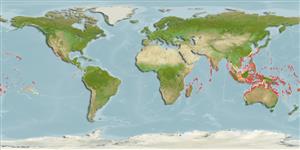Common names from other countries
>
Tetraodontiformes (Puffers and filefishes) >
Tetraodontidae (Puffers) > Canthigasterinae
Etymology: Canthigaster: Greek, kanthos = the outer or inner corner of the eye, where the lids meet, 1646 + Greek, gaster = stomach (Ref. 45335).
More on author: Bleeker.
Environment: milieu / climate zone / depth range / distribution range
Οικολογία
Θαλασσινό(ά) Υφαλόφιλο(α); εύρος βάθους 1 - 30 m (Ref. 1602). Tropical; 32°N - 32°S
Indo-Pacific: East Africa south to Transkei, South Africa (Ref. 4919) and east to the Line, Marquesan, and Oeno islands, north to southern Japan, south to Lord Howe Island. Replaced by Canthigaster jactator in the Hawaiian Islands and Canthigaster punctatissimus in the tropical eastern Pacific (Ref. 37816). Also recorded from Southeast Atlantic.
Μέγεθος / Βάρος / Age
Maturity: Lm ? range ? - ? cm
Max length : 9.0 cm TL αρσενικό/απροσδιόριστο; (Ref. 4919)
Short description
Κλείδες προσδιορισμού | Μορφολογία | Μορφομετρία
Ραχιαίες άκανθες (συνολικά) : 0; Μαλακές ραχιαίες ακτίνες (συνολικά) : 9 - 10; Εδρικές άκανθες: 0; Μαλακές εδρικές ακτίνες: 9 - 10. Many white spots scattered on body (Ref. 559).
Occurs in clear lagoon and seaward reefs, Ref. 48637. Found with sponges at various depths (Ref. 48637). Prefers sheltered areas in the form of holes in dead and living corals. Solitary or paired. Feeds on sponges, polychaetes, filamentous algae and on smaller quantities of tunicates, crustaceans, echinoderms and corals.
Life cycle and mating behavior
Maturities | Αναπαραγωγή | Spawnings | Egg(s) | Fecundities | Προνύμφες
Myers, R.F., 1991. Micronesian reef fishes. Second Ed. Coral Graphics, Barrigada, Guam. 298 p. (Ref. 1602)
IUCN Red List Status (Ref. 130435)
CITES (Ref. 128078)
Not Evaluated
Threat to humans
Harmless
Human uses
αλιεία: Εμπορικό(ά); Ενυδρείο: Εμπορικό(ά)
Εργαλεία
Special reports
Download XML
Διαδικτυακές πηγές
Estimates based on models
Preferred temperature (Ref.
115969): 24.7 - 29.3, mean 28.3 (based on 2816 cells).
Phylogenetic diversity index (Ref.
82804): PD
50 = 0.5000 [Uniqueness, from 0.5 = low to 2.0 = high].
Bayesian length-weight: a=0.03631 (0.01554 - 0.08482), b=2.88 (2.69 - 3.07), in cm Total Length, based on LWR estimates for this Genus-body shape (Ref.
93245).
Τροφικό Επίπεδο (Ref.
69278): 3.1 ±0.32 se; based on food items.
Ελαστικότητα (Ref.
120179): Υψηλό, ελάχιστος χρόνος για διπλασιασμό πληθυσμού < 15 μήνες (Preliminary K or Fecundity.).
Fishing Vulnerability (Ref.
59153): Low vulnerability (10 of 100).
